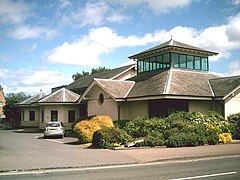Carterton, Oxfordshire
| Carterton | |
|---|---|
 St John the Evangelist parish church |
|
| Carterton shown within Oxfordshire | |
| Population | 15,769 (2011 Census) |
| OS grid reference | SP2806 |
| • London | 72.4 miles (116.5 km) |
| Civil parish |
|
| District | |
| Shire county | |
| Region | |
| Country | England |
| Sovereign state | United Kingdom |
| Post town | Carterton |
| Postcode district | OX18 |
| Dialling code | 01993 |
| Police | Thames Valley |
| Fire | Oxfordshire |
| Ambulance | South Central |
| EU Parliament | South East England |
| UK Parliament | |
| Website | Carterton Cummunity Website |
Carterton is the second largest town in West Oxfordshire and is 2 miles (3 km) south of the A40 road and 4 miles (6.4 km) south-west of Witney. The 2011 Census recorded the parish's population as 15,769.
Much of what is now the northern part of the town was held by the Moleyns family from at least 1369, but in 1429 William Lord Moleyns was killed at the siege of Orleans and the land passed to the Hungerford family. During the mediaeval period the main road through Carterton was one of the most important in the country, taking trains of packhorses laden with Cotswold wool over Radcot Bridge and on to Southampton for export to the weaving centres of Europe.
In the 1770s the land was acquired by the Duke of Marlborough.
The pattern of the present settlement dates from 1894 when part of the estate was sold to Homesteads Limited whose director was William Carter. The land was divided into plots of 6 acres and sold for £20 an acre with bungalows costing from £120. Many of the settlers were retired soldiers and people moving from the towns. Carterton soon made its name in the market gardening world. Black grapes from Frenchester Nurseries and the famous Carterton tomatoes were sold at Covent Garden Market.
Construction work on RAF Brize Norton began in 1935. Wartime saw the rapid growth of the base. Following a raid which destroyed 46 aircraft, the remainder were dispersed round the village and one hangar which is now an Aldi supermarket on the Alvescot Road. From 1950 to 1965 the camp was to be the home of the USAF bomber wings. The RAF returned in 1965 and undertook a large building programme making RAF Brize Norton its main air transport base in the country.
With the growth of the village, the small mission church at the central crossroads was replaced in 1963 by the church of St. John the Evangelist. The link with the mother church of St. Mary's at Black Bourton was kept alive by the donation of one of the bells from the tower. This was made by H. Knight of Reading and is dated 1619.
In the first decade of the 21st century the new Shilton Park district of northeast Carterton was built, providing a mix of housing for private ownership and social letting. The new St. John's Church of England primary school has been built at Shilton Park and construction of a local shopping centre is now complete.
A new memorial garden has been built near the town to continue the public mourning seen at Royal Wootton Bassett as military repatriations for dead service personnel have now been routed to Brize Norton.
...
Wikipedia

